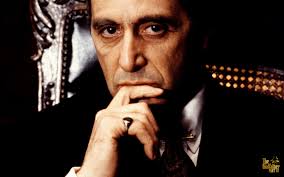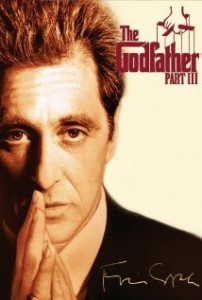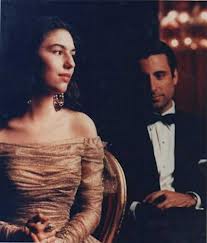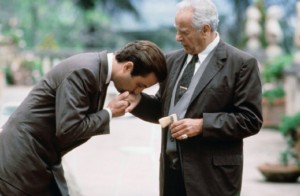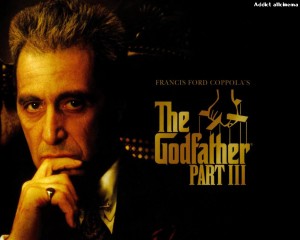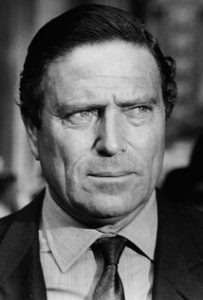The Godfather: Part III ****½ (1990, Al Pacino, Andy Garcia, Talia Shire, Diane Keaton, Eli Wallach, Joe Mantegna, Sofia Coppola, Raf Vallone, Donal Donnelly) – Classic Movie Review 28
Michael Corleone: ‘Just when I thought I was out, they pull me back in.’
Quibbles apart, Francis Ford Coppola’s 1990 crime film The Godfather: Part III is a worthy successor to his first two films.
There were considerable mumblings of disappointment at this 1990 final part of the Godfather saga, and it certainly isn’t quite the triumph of the first two movies. But Francis Ford Coppola still manages to astonish again in this rather splendid grand finale to the gangster tragedy that is Shakespearean in its ambitions and not too far short in its achievements.
A startlingly grey, haggard and haunted-looking Al Pacino impresses once more in this middle-aged updating of his role as the Godfather, Michael Corleone, now in 1979 trying to go straight by conducting only legitimate business, but, inevitably, reluctantly being pulled back into ‘family business’, with tragic consequences. He is astonishingly convincing and powerful as the ageing, blank-eyed Mafia boss, irreparably corrupted by the power of his position and his past deeds.
Andy Garcia is outstanding too as his bright but hot-headed young nephew, Vincent Mancini, whom he starts to mould into his Mob protégé and eventual successor, while Talia Shire is a firecracker, coming on as a real Lady Macbeth as the Godfather’s increasingly powerful, conniving and unhinged sister Connie.
The increasingly tense build-up to the climax is punctuated by scenes of suspense, brilliant set pieces and bursts of violence as the tragedy works its devious way to a dazzlingly orchestrated suspense climax at the magnificent Teatro Massimo opera house in Palermo, Sicily. It seems to go on for ever, completing the Godfather trilogy in the most astounding display of fireworks.
The family goes to Sicily for the opera-singing son Anthony Vito Corleone’s operatic debut in Palermo at the Teatro Massimo, watching his performance in Cavalleria Rusticana, while Vincent and Connie exact their revenge.
When Winona Rider pulled out at the last minute from the major role of Pacino’s daughter Mary, the director caused controversy by replacing her with his inexperienced daughter Sofia Coppola, and she gathered appalling, abusive flack for her acting, but she is plenty good enough. Her girlish inexperience and innocent appeal work well with the character, keeping it well away from the kind of actressy performance a more established actress might have offered.
However, the lack of Robert Duvall as Tom Hagen the Godfather’s consigiliere, or legal adviser, is a considerable drawback, and George Hamilton’s B J Harrison character is insufficient substitute, especially as he has so little screen time, his role apparently cut. Otherwise, there are signs that Hamilton might have been quite good.
Eli Wallach has a most satisfying role as the candy-addicted mobster Don Altobello (‘The richest man is the one with the most powerful friends’). He may not be very Italian, but he is very good, and very entertaining. Donal Donnelly is outstanding as the chilling Archbishop Gilday, Raf Vallone (1916–2002) is excellent in the key role of Cardinal Lamberto, who becomes Pope John Paul I, and Enzo Robutti is nice and creepy as Don Licio Lucchesi (‘You understand guns? Finance is a gun. Politics is knowing when to pull the trigger.’)
Also notable are Joe Mantegna as the hotheaded mobster Joey Zasa and Bridget Fonda as reporter Grace Hamilton who falls for Vincent Corleone. Plus Richard Bright as Al Neri, Franco Citti as old bodyguard Calò, Mario Donatone as the veteran hitman Mosca, Vittorio Duse as Don Tommasino, and Helmut Berger as Vatican accountant Frederick Keinszig are all welcome and important presences.
Also in the cast are Franc D’Ambrosio as the opera-singing son Anthony Vito Corleone, John Savage, Richard Bright, Al Martino, Mario Donatone, and John Albineri.
There are many great scenes and great moments, larger and smaller. One of the smaller is one of the best. Vallone’s scene with Pacino where he takes his confession and grants him the Rite of Absolution (‘Your sins are terrible. It is just that you suffer. Your life could be redeemed, but I know you don’t believe that. You will not change.’) is a magnificent little gem.
Quibbles apart, The Godfather: Part III is a worthy successor to the first two films.
The video version ‘Director’s Cut’ is re-edited by Coppola and restores nine minutes of the original footage. It was said to be the first film to cost $100 million, $55 million for the budget and the rest for advertising and promotion: to date it has only raised $135 million at the box office, though TV and DVD sales may have put it in profit. Coppola and author Mario Puzo were working on a Part 4, a plan stopped by the latter’s death in 1999.
There were seven Oscar nominations and seven Golden Globe nominations, but unfairly no wins at all.
Sofia Coppola won two Razzies for Worst Supporting Actress and Worst New Actress – how mean is that? She had the last laugh, going on to an impressive career as writer-director.
A new cut of The Godfather: Part III premieres in cinemas in December 2020 to celebrate the film’s 30th anniversary. Paramount Pictures announced on 4 September 2020 that Mario Puzo’s The Godfather Coda: The Death of Michael Corleone achieves Coppola’s and Puzo’s original vision for the finale.
Coppola’s new cut had a limited theatrical release on 4 December 2020, followed by digital and Blu-ray releases on 8 December 2020. The recut includes changes to the beginning and the ending of the film and some re-edited scenes and musical cues. The runtime is 158 minutes compared to the original film’s 162 minutes.
Coppola said this is the version that he and Puzo had originally envisioned and that it vindicates its status in The Godfather trilogy, as well as his daughter Sofia’s performance. Pacino and Keaton gave their approval to the recut film, noting it as an improvement over the original film.
Parts of the story are loosely based on historical events around the ending of the papacy of Pope Paul VI, the short tenure of Pope John Paul I in 1978 and the collapse of the Banco Ambrosiano in 1982. The character and look of Swiss banker Frederick Keinszig, who is murdered and left hanging under a bridge, mirrors Roberto Calvi, the Italian head of the Banco Ambrosian, found hanging under Blackfriars Bridge in London in 1982.
The cast are Al Pacino as Michael Corleone, Diane Keaton as Kay Adams-Corleone, Talia Shire as Connie Corleone, Andy García as Vincent Corleone, Eli Wallach as Don Altobello, Joe Mantegna as Joey Zasa, George Hamilton as B.J. Harrison, Bridget Fonda as Grace Hamilton, Sofia Coppola as Mary Corleone, Raf Vallone as Cardinal Lamberto, Franc D’Ambrosio as Anthony Corleone, Donal Donnelly as Archbishop Gilday, Richard Bright as Al Neri, Al Martino as Johnny Fontane, Helmut Berger as Frederick Keinszig, Don Novello as Dominic Abbandando, John Savage as Father Andrew Hagen, Franco Citti as Calò, Mario Donatone as Mosca, Vittorio Duse as Don Tommasino, Enzo Robutti as Don Licio Lucchesi, Michele Russo as Spara, Robert Cicchini as Lou Pennino, Rogerio Miranda as Armand, Carlos Miranda as Francesco, Vito Antuofermo as Anthony Squigliaro, Mickey Knox as Marty Parisi, Jeannie Linero as Lucy Mancini, Carmine Caridi as Albert Volpe, Don Costello as Frank Romano, Al Ruscio as Leo Cuneo, Rick Aviles as Mask #1, Michael Bowen as Mask #2, John Abineri as Hamilton Banker, Marino Masé as Lupo, Dado Ruspoli as Vanni, Valeria Sabel as Sister Vincenza, Remo Remotti as Cardinal Sistine, Anthony Guidera as Anthony the Bodyguard, Jessica DiCicco as Child and Catherine Scorsese as Woman in Café.
Eli Wallach died on 24 June 2014 aged 98. Wallach, who won a Tony Award in 1951 for playing Alvaro in Tennessee Williams’s original production of The Rose Tattoo, made his movie debut as a cotton-gin owner trying to seduce a virgin in Elia Kazan’s Baby Doll (1956) and carried on working well into his nineties.
http://derekwinnert.com/the-godfather-classic-film-review-2/
http://derekwinnert.com/the-godfather-part-ii-classic-film-review-3/
© Derek Winnert 2013 Classic Movie Review 28
Link to Derek Winnert’s home page for more film reviews: http://derekwinnert.com/

